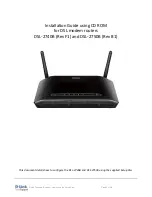
408
Step Command
Remarks
3.
Configure a service
identifier.
ipv6 subscriber service-identify
{
8021p
{
second-vlan
|
vlan
} |
dscp
|
second-vlan
|
vlan
}
By default, no service identifier is
configured for DHCPv6 users, IPv6
unclassified-IP users, static
individual users, and leased users.
Only subinterfaces support
parameters
8021p
,
second-vlan
and
vlan
.
4.
Configure
service-specific ISP
domains for IPv6
users.
•
Bind an ISP domain to a VLAN
list:
ipv6 subscriber vlan vlan-list
domain domain-name
•
Bind an ISP domain to an 802.1p
list:
ipv6 subscriber 8021p
8021p-list
domain domain-name
•
Bind an ISP domain to a DSCP
list:
ipv6 subscriber dscp
dscp-value-list domain
domain-name
By default, no service-specific ISP
domains are configured for
DHCPv6 users, IPv6
unclassified-IP users, static
individual users, and leased users.
For DHCPv6 users, the trusted
Option 16 or Option 17
configuration takes precedence
over the global service identifier
configuration.
Only subinterfaces support
commands
ipv6 subscriber vlan
and
ipv6 subscriber 8021p
.
Configuring the quiet feature for users
If this feature is enabled, the quiet timer starts when number of consecutive authentication failures of
a user reaches the limit in the specified period. During the quiet timer period, packets from the user
are discarded. After the quiet timer expires, the BRAS performs authentication upon receiving a
packet from the user. This feature can prevent password attacks.
To configure the quiet feature for users:
Step Command
Remarks
1.
Enter system view.
system-view
N/A
2.
Enter interface view.
interface
interface-type
interface-number
N/A
3.
Configure the quiet
timer for users.
•
For IPv4 users:
ip subscriber timer quiet
time
•
For IPv6 users:
ipv6 subscriber timer quiet
time
By default, the quite timer is
disabled.
4.
(Optional.) Configure
the authentication
failure limit in the
specified period that
triggers the quiet
timer.
•
For IPv4 users:
ip subscriber authentication
chasten auth-failure auth-period
•
For IPv6 users:
ipv6 subscriber authentication
chasten auth-failure auth-period
By default, the quiet timer starts
immediately upon one
authentication failure.
This command takes effect only
after the quiet timer is enabled on
the interface.
Configuring online detection for users
Online detection enables the BRAS to periodically detect the status of a user. It uses ARP or ICMP
requests to detect IPv4 users, and uses ND NS or ICMPv6 requests to detect IPv6 users.
















































